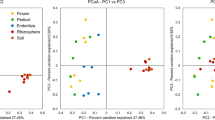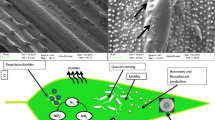Abstract
We studied the structure and diversity of the phyllosphere bacterial community of a Mediterranean ecosystem, in summer, the most stressful season in this environment. To this aim, we selected nine dominant perennial species, namely Arbutus unedo, Cistus incanus, Lavandula stoechas, Myrtus communis, Phillyrea latifolia, Pistacia lentiscus, Quercus coccifera (woody), Calamintha nepeta, and Melissa officinalis (herbaceous). We also examined the extent to which airborne bacteria resemble the epiphytic ones. Genotype composition of the leaf and airborne bacteria was analysed by using denaturing gradient gel electrophoresis profiling of a 16S rDNA gene fragment; 75 bands were cloned and sequenced corresponding to 28 taxa. Of these, two were found both in the air and the phyllosphere, eight only in the air, and the remaining 18 only in the phyllosphere. Only four taxa were found on leaves of all nine plant species. Cluster analysis showed highest similarity for the five evergreen sclerophyllous species. Aromatic plants were not grouped all together: the representatives of Lamiaceae, bearing both glandular and non-glandular trichomes, formed a separate group, whereas the aromatic and evergreen sclerophyllous M. communis was grouped with the other species of the same habit. The epiphytic communities that were the richest in bacterial taxa were those of C. nepeta and M. officinalis (Lamiaceae). Our results highlight the remarkable presence of lactic acid bacteria in the phyllosphere under the harsh conditions of the Mediterranean summer, the profound dissimilarity in the structure of bacterial communities in phyllosphere and air, and the remarkable differences of leaf microbial communities on neighbouring plants subjected to similar microbial inocula; they also point to the importance of the leaf glandular trichome in determining colonization patterns.




Similar content being viewed by others
References
Andrews JH (1992) Biological control in the phyllosphere. Annu Rev Phytopathol 30:603–635
Baldotto LEB, Olivares FL (2008) Phyloepiphytic interaction between bacteria and different plant species in a tropical agricultural system. Can J Microbiol 54:918–931
Bowers RM, McLetchie S, Knight R, Fierer N (2011) Spatial variability in airborne bacterial communities across land-use types and their relationship to the bacterial communities of potential source environments. ISME J 5:601–612
Chalkos DG (2010) Effects of secondary metabolites of aromatic plants on the structure and metabolism of the soil microbial communities. PhD thesis. Aristotle University of Thessaloniki: Thessaloniki, Greece (in Greek with English summary)
Constantinidou ΗΑ, Hirano SS, Baker LS, Upper CD (1990) Atmospheric dispersal of ice nucleation-active bacteria: the role of rain. Phytopathology 80:934–937
de Jager ES, Wehner FC, Korsten L (2001) Microbial ecology of the mango phylloplane. Microb Ecol 42:201–207
Delmotte N, Knief C, Chaffron S, Innerebner G, Roschitzki B, Schlapbach R, von Meringb C, Vorholta JA (2009) Community proteogenomics reveals insights into the physiology of phyllosphere bacteria. Proc Natl Acad Sci USA 106:16428–16433
Fierer N, McCain CM, Meir P, Zimmermann M, Rapp JM, Silman MR, Knight R (2011) Microbes do not follow the elevation diversity patterns of plants and animals. Ecology 92:797–804
Karamanoli K, Vokou D, Menkissoglu O, Constantinidou HΙ (2000) Bacterial colonization of the phyllosphere of Mediterranean aromatic plants. J Chem Ecol 26:2035–2048
Knief C, Ramette A, Frances L, Alonso-Blanco C, Vorholt JA (2010) Site and plant species are important determinants of the Methylobacterium community composition in the plant phyllosphere. ISME J 4:719–728
Lambais MR, Crowley DE, Cury JC, Bull RC, Rodrigues RR (2006) Bacterial diversity in tree canopies of the Atlantic forest. Science 312:1917–1917
Lavermicocca P, Gobbetti M, Corsetti A, Caputo L (1998) Characterization of lactic acid bacteria isolated from olive phylloplane and table olive brines. Ital J Food Sci 10:27–39
Lindemann J, Constantinidou HΑ, Barchet WR, Upper CD (1982) Plants as sources of airborne bacteria, including ice nucleation-active bacteria. Appl Environ Microbiol 44:1059–1063
Lindow SE (1996) Role of immigration and other processes in determining epiphytic bacterial populations: implications for disease management. In: Morris CE, Nicot PC, Nguyen C (eds) Aerial plant surface microbiology. Plenum, New York, pp 155–168
Mariano RLR, McCarter SM (1993) Epiphytic survival of Pseudomonas viridiflava on tomato and selected weed species. Microb Ecol 26:47–58
Mew TW, Vera Cruz CM (1986) Epiphytic colonization of host and non-host plants by phytopathogenic bacteria. In: Fokkema NJ, van den Heuvel J (eds) Microbiology of the phyllosphere. Cambridge University Press, New York, pp 269–282
Muller T, Behrendt U, Muller M (1996) Antagonistic activity in plant-associated lactic acid bacteria. Microbiol Res 151:63–70
Mundt JO, Coggins JH, Johnson LF (1962) Growth of Streptococcus faecalis var. liquefaciens on plants. Appl Microbiol 10:552–555
Muyzer G, Teske A, Wirsen CO, Jannasch HW (1995) Phylogenetic relationships of Thiomicrospira species and their identification in deep-sea hydrothermal vent samples by denaturing gradient gel electrophoresis of 16S rDNA fragments. Arch Microbiol 164:165–171
Pugh GJF, Buckley NJ (1971) The leaf surface as substrate for colonization by fungi. In: Preece TF, Dickinson CH (eds) Ecology of leaf surface micro-organisms. Academic, London, pp 431–445
Quaiser A, Ochsenreiter T, Lanz C, Schuster SC, Treusch AH, Eck J, Schleper C (2003) Acidobacteria form a coherent but highly diverse group within the bacterial domain: evidence from environmental genomics. Mol Microbiol 50:563–575
Redford AJ, Bowers RM, Knight R, Linhart Y, Fierer N (2010) The ecology of the phyllosphere: geographic and phylogenetic variability in the distribution of bacteria on tree leaves. Environ Microbiol 12:2885–2893
Schönherr J, Baur P (1996) Cuticle permeability studies: a model for estimating leaching of plant metabolites to leaf surfaces. In: Morris CE, Nicot PC, Nguyen C (eds) Aerial plant surface microbiology. Plenum, New York, pp 1–23
Sokal R, Michener C (1958) A statistical method for evaluating systematic relationships. Univ Kans Sci Bull 38:1409–1438
Vareli K, Briasoulis E, Pilidis G, Sainis I (2009) Molecular confirmation of Planktothrix rubescens as the cause of intense, microcystin-synthesizing cyanobacterial bloom in Lake Ziros, Greece. Harmful Algae 8:447–453
Vokou D (2007) Allelochemicals, allelopathy and essential oils: a field in search of definitions and structure. Allelopathy J 19:119–135
Vokou D, Chalkos D, Karamanoli K (2006) Microorganisms and allelopathy: a one-sided approach. In: Reigosa MJ, Pedrol N, Gonzalez L (eds) Allelopathy: a physiological process with ecological implications. Springer, Dordrecht, pp 341–371
Vokou D, Margaris NS (1988) Decomposition of terpenes by soil microorganisms. Pedobiologia 31:413–419
Vokou D, Margaris NS, Lynch JM (1984) Effects of volatile oils from aromatic shrubs on soil microorganisms. Soil Biol Biochem 16:509–513
Whipps JM, Hand P, Pink D, Bending GD (2008) Phyllosphere microbiology with special reference to diversity and plant genotype. J Appl Microbiol 105:1744–1755
Yadav RKP, Bosabalidis AM, Vokou D (2004) Leaf structural features of Mediterranean perennial species: plasticity and life form specificity. J Biol Res 2:21–34
Yadav RKP, Halley JM, Karamanoli K, Constantinidou HI, Vokou D (2004) Bacterial populations on the leaves of Mediterranean plants: quantitative features and testing of distribution models. Environ Exp Bot 52:63–77
Yadav RKP, Karamanoli K, Vokou D (2011) Bacterial populations on the phyllosphere of Mediterranean plants: influence of leaf age and leaf surface. Front Agr China 5:60–63
Yadav RKP, Karamanoli K, Vokou D (2005) Bacterial colonization of the phyllosphere of Mediterranean perennial species as influenced by leaf structural and chemical features. Microb Ecol 50:185–196
Yadav RKP, Papatheodorou EM, Karamanoli K, Constantinidou H-IA, Vokou D (2008) Abundance and diversity of the phyllosphere bacterial communities of Mediterranean perennial plants that differ in leaf chemistry. Chemoecology 18:217–226
Yang CH, Crowley DE, Borneman J, Keen NT (2001) Microbial phyllosphere populations are more complex than previously realized. Proc Natl Acad Sci USA 98:3889–3894
Acknowledgements
We thank Prof. S. E. Lindow, University of California, Berkeley, for his constructive comments on an earlier version of our manuscript.
Author information
Authors and Affiliations
Corresponding author
Rights and permissions
About this article
Cite this article
Vokou, D., Vareli, K., Zarali, E. et al. Exploring Biodiversity in the Bacterial Community of the Mediterranean Phyllosphere and its Relationship with Airborne Bacteria. Microb Ecol 64, 714–724 (2012). https://doi.org/10.1007/s00248-012-0053-7
Received:
Accepted:
Published:
Issue Date:
DOI: https://doi.org/10.1007/s00248-012-0053-7




